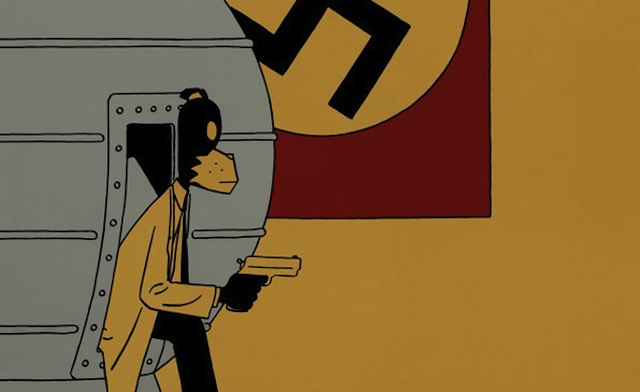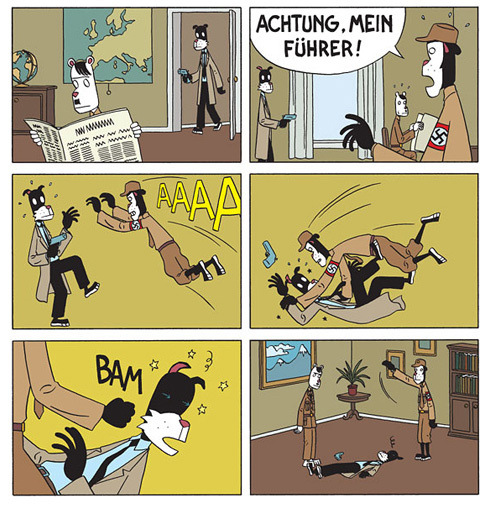Our life with Adolf

Oh, Hitler! What would you have thought about how much literary and artistic inspiration your heinous political persona has given the world over the last seventy-odd years?
It’s an interesting conundrum to think about how much influence the actions of this failed art student (enveloped in the form of a mad dictator) have had on the world of imagination. On one hand, it should be no surprise that, so long as the Holocaust survivor narrative continues — by first hand account or recorded for future generations — we wrestle with the atrocity that was the systematic genocide of millions of Jews, homosexuals, Romani and people with disabilities, among others. Nazism remains a deep, unhealed scar on the Western world, perhaps always to be so, that practically begs interaction with the artistic mind. We write, draw, film, and craft to work out our demons and attempt to unravel reality toward a full understanding of its meaning. I spent two years in college studying with one of the foremost American minds on the philosophical reach of the Holocaust* and my mind still remains overwhelmed by its consequences. Some spend their entire careers as such.
Comic books, because of their development and growth in the era surrounding World War II, have an inextricable connection to the Nazi threat. Captain America and many more heroes of the Golden Age owe their origins in one form or another to these events. War comics, such as Sgt. Rock and G.I. Combat, spanned decades of publication, depicting the fight against Hitler’s rise month in and month out for readers on the edge of their seats. Time has marched on, of course, as the marketplace finds less viability for the war comic genre. Even the Justice Society of America has replaced Nazism in its core narrative with an inter-dimensional threat in order to maintain the credibility of its members’ ages — if not just because the battles of World War II now feel distant to a younger readership. Yet, despite all this, Hitler and his directives still pervade the public consciousness, perhaps more sharply than ever before.
But where does a struggle to understand bleed over into monumentalizing a single man? From Quentin Tarantino’s film Inglouious Basterds, a stylized Jewish revenge fantasy about hunting down Nazis and killing Hitler, to Maurizio Cattelan’s photorealistic sculpture of Hitler Kneeling as a supplicant child, artists continue to engage not just with the historical context, but with the man himself. We continue to go back to the well with Adolf, ever transforming him into a character as commodified as Mickey Mouse or Superman — an irony that should not be lost on students of history. Indeed he is foremost depicted today as either an inept laughingstock (think Hitler’s Reaction to Halo 4) or a surmountable foe, but he remains a singular part of the cultural zeitgeist decades later. His personal presence is enshrined not simply in history, but truly in posterity.
As if to hit that particular nail on the head, arrived I Killed Adolf Hitler, the 2007 graphic novel by Norwegian writer/artist Jason, distributed in the United States by Fantagraphics Books. A uniquely touching, yet amusing, tale of melancholic love and obligation, I Killed Adolf Hitler is set in a world where murder-for-hire is a legal profession. The main character is approached by a scientist to take on a very challenging assignment — the murder of Adolf Hitler. It seems the scientist has developed a time machine, which only now, after fifty years, is fully charged and ready for a round trip expedition to 1938 Germany. The killer simply must step inside and push a single button, and emerge to shoot Hitler before repeating the trip back home. Simple enough.


Of course, as little time travel ever goes precisely as planned, the killer is overwhelmed by Hitler’s guard and replaced in the time capsule by the Fuhrer himself. Now arriving in the present day, Hitler is met by the killer again, seventy years older — not nearly as spry as in his professional heyday. The end result is a vanished dictator, a disappointed client, and a man out of time, returned to the life he once knew a much older and exhausted figure.

Like Maus long before it, there’s a psychology to depicting tough emotional content with anthropomorphized subjects. In this case, it’s not atrocity or inhumanity that needs exaggeration as much as a certain melancholia and seriousness that requires undermining. In a world where Hitler roams free and assassination is a viable profession not unlike medicine or the law, to experience human disappointment and anxiety through a collection of dogs, rabbits and birds alleviates a bit of narrative weight. That is to say, there’s a built-in affection that comes with a canine killer and his erstwhile girlfriend that permeates every panel. Jason’s art is simultaneously adorable and moody, with autumnal colors throughout reflecting back the aged nature of a protagonist who had to time travel back home the hard way — one day at a time. Wrinkles upon the brow and eyes of a dog, one must admit, are far more endearing than on any human being.
The sense of silence throughout the graphic novel reflects back on the idea of distance as well — distance traveled through time and the emotional distance between the killer and his former girlfriend. For this isn’t science fiction, nor is it historical narrative. I Killed Adolf Hitler is a love story between two people who may not particularly like each other, but grow to a fondness that may simulate need. Jason doesn’t use captions or thought bubbles, and his dialogue — sometimes witty, sometimes simply functional — takes second place to the advanced sense of body language and posture he infuses in each character. Figures slouch, remain barefoot and vulnerable to the world, and find themselves staring blankly toward doorways or across streets. Never quite where they anticipated ending up, all the characters seem listless, but not fully resigned. Momentum may be ever so slow, but it still exists in this inverted existence, much like the experience of late life aging itself.

Ultimately, the Fuhrer is no more than a MacGuffin for the plot of I Killed Adolf Hitler, a reason to separate the killer from the life he knew and return him in a different emotional state. His place in this heartfelt narrative is merely utilitarian, one of the most frightening men of the twentieth century reduced to a caricature running off panel. And yet, maybe that’s the true irony of Hitler’s own creative ambition and ruthless attempts at posterity. For such a horror to be summarized in a cartoonish footnote, perhaps power truly has shifted out of the hands of evil into the imagination of a world thriving in his absence. I may never be fully resigned to seeing old Adolf jumping across my screen or page with impunity, but I can certainly join the wrinkled canine protagonist in raising a glass to his demise. “Fuck you, Adolf Hitler” indeed.
—
* Want to experience that mind firsthand? Look up Vessels of Evil: American Slavery and the Holocaust by my mentor and brilliant sophisticate Laurence Mordekhai Thomas. It’s challenging, but you won’t be sorry.
—
Matt Santori-Griffith owns one business suit, three pairs of shoes, and over 15,000 comic books. He is an art director for several non-profit organizations, senior editor for Comicosity.com, and still manages to find the time on dark nights and weekends to fight the good fight on Twitter.com in the guise of @FotoCub. He has not yet saved the world, but isn’t giving up quite yet.